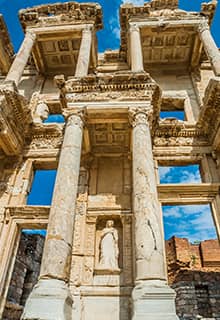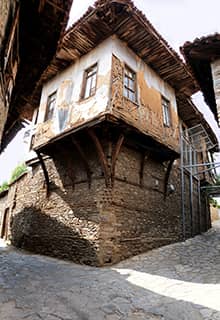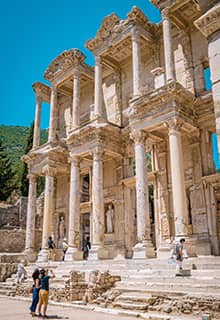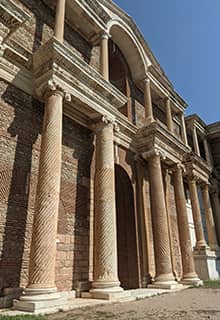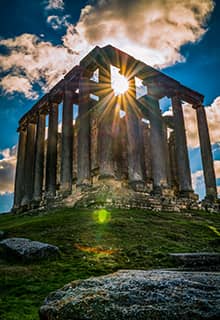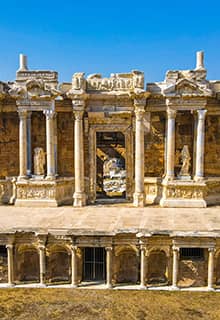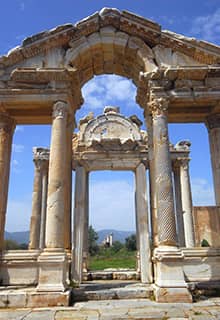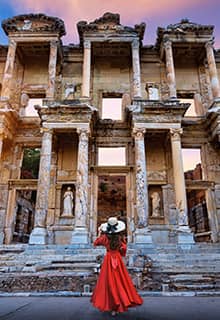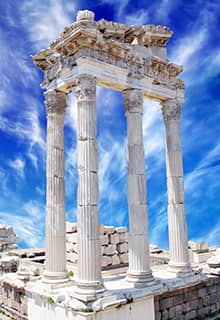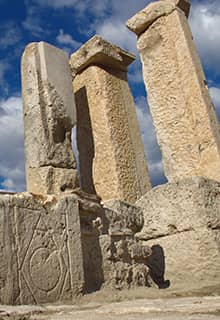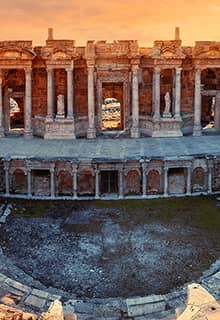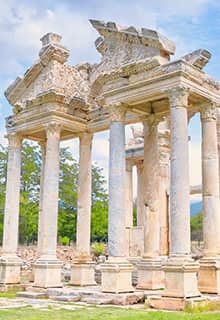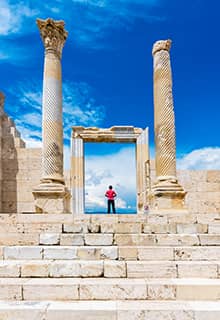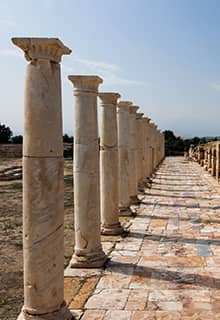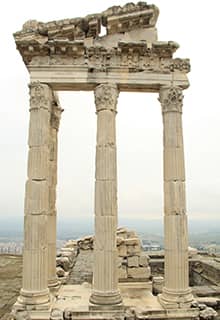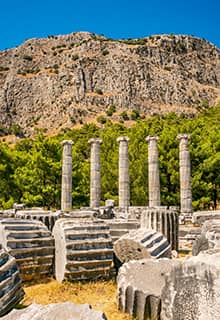

Aegean Türkiye
UNESCO Heritage Sites and Routes
Mausoleum and Sacred Area of Hecatomnus, Muğla
UNESCO World Heritage Tentative List 2012
The Mausoleum of Hecatomnus is located on the east side of Hisarbaşı Hill in the Milas district of Muğla. Hecatomnus of Mylasa (today’s Milas) was the father of the famous Mausolus, whose wife Artemisia built the Mausoleum of Halicarnassus, a monumental shrine in his honor that became one of the Seven Wonders of the Ancient World. The Mausoleum of Hecatomnus had been defined in various studies as a “temple,” but recent research has revealed that it is a monumental tomb. With regard to its architectural features, it is possible to date the tomb to the early 4th century BC. Considering the burial customs of the period when Hecatomnus was a satrap and considering that Mylasa was the capital of Caria at the time, the tomb most certainly belongs to Hecatomnus and his family. In addition, the low reliefs on the sarcophagus and the iconography of the wall paintings support the argument that this mausoleum belonged to Hecatomnus. The mausoleum and sacred area of Hecatomnus include a temenos; the Menandros (Menander) Column, a monumental column dedicated to Menander which once probably had a statue of him on top; a podium; and the mausoleum which consists of a load-bearing room (to lessen the load of the burial room), a burial room, a sarcophagus, and a dromos, the entrance passage leading to the tomb. The Mausoleum of Hecatomnus, a prime example of Carian art and architecture, is considered a predecessor of the Mausoleum of Halicarnassus.
Xanthos-Letoon, Muğla
UNESCO World Heritage Site 1988
“I came all the way from distant Lycia, from the eddying Xanthos river,” says Sarpedon, the Lycian hero in the Iliad. Indeed, Xanthos was the capital city of Lycia in the early Lycian times. The city’s residents committed mass suicide at least two times in the city’s history instead of surrendering to the enemy. The first time was in 546 BC, during the Persian invasion, and the second time was in the 1st century BC when Brutus came to Lycia to gather forces. Ruins from the city’s days of glory can be found throughout the city. In a typical Lycian tradition, the city center is decorated with beautiful Lycian tombs, most of them with reliefs and inscriptions both in the Lycian language, an Indo-European language, and Greek. Unfortunately, a lot of antiquities were removed from Xanthos in the 19th century when Sir Charles Fellows came to Lycia and shipped dozens of boxes full of Lycian art back to England. These antiquities today are displayed at the British Museum in London.
The Xanthos River (Eşen Çayı in Turkish) flows next to the city and the view from the acropolis is outstanding. Visitors first arrive at the city gate and on the way to the agora, they come across the foundations of the Nereid Monument, currently at the British Museum. At the agora, Lycian funerary monuments can be found that are unique in all of antiquity. Directly north of the Acropolis stands a beautiful theater that dominates the Roman agora. During Byzantine and Hellenistic times, a church was built at the northeast corner while an advanced defensive structure protected the western side of the citadel along the river.
Not far from Xanthos, just 10 km south of the Lycian city, there is Letoon, Xanthos’s cult center. Letoon was the federal sanctuary of the Lycian province and of the Lycian League. The archaeological excavations date the sanctuary as early as the 7th century BC. During the Hellenistic period, three temples were built here: a temple dedicated to Leto in the middle, and temples dedicated to Artemis and Apollo on either side of Leto’s temple. As we are told by Ovid, the Latin poet, Zeus, fell in love with the nymph Leto. When Leto became pregnant by Zeus, his jealous wife Hera chased Leto from the island of Delos. Leto came all the way to Lycia and gave birth to twins, Artemis and Apollo. This version of mythology, establishes Lucia as the gods Artemis and Apollo’s birthplace. The three temples were excavated by French archaeologists. The site also includes the ruins of a nymphaeum dating back to Roman Emperor Hadrian.
Ancient City of Stratonikeia, Muğla
UNESCO World Heritage Tentative List 2015
Stratonikeia (Stratonicea) lies 50 km east of Muğla, the provincial capital of the area, near the village of Eskihisar. It was one of the most important towns of ancient Caria. According to historical sources, the city was established by Antiochus I Soter, a Seleucid king, who named it “Stratonikeia” after his wife Stratonike (Stratonice of Syria) in the 3rd century BC. Important ruins include the acropolis, the city gate, an agora, a bouleuterion, and well-preserved tombs. At the same time, the nearby village of Eskihisar offers visitors the opportunity to admire some remarkable examples of Ottoman civil architecture.
Medieval City of Beçin, Muğla
UNESCO World Heritage Tentative List 2012
Beçin is located 5 km south of Milas District, on the road to the ancient city of Keramos (Ören). The settlement dates back to the Geometric and Archaic periods. It was continuously settled during the Classical, Roman, Byzantine, Turkish Menteşeoğulları Sultanate (Mentese Beylik), and Ottoman periods. However, it was not a prominent city in ancient times or in the Byzantine period. It rose to prominence in the second half of the 13th century, and especially as the capital of the Menteşeoğulları Sultanate, which existed for more than 200 years. A fortress and the main settlement area in the south of this fortress constituted the city of Beçin. Within the fortress, among other archaeological ruins, are the Kızıl Han (a caravanserai), the Kara Paşa Han, and the Emir Courtyard, the Orman Lodge, the New Church, and the Byzantine Chapel. Other prominent structures are the inner citadel, the anonymous tombs, the Büyük Hammam (large Turkish bath), Zaviye, the Mültezim House, the Orhan Mosque, Hankah, Ahmet Gazi Madrasa, the Bey Mansion and Bath, the Domed Fountain, Kızılhan, Seymenlik Zaviye, Menteşe Cemetery, Yelli Külliye, and the Kara Paşa Madrasa. Most of these structures date to the 14th and 15th centuries except the citadel which was built from material dating back to antiquity.
Aphrodisias, Aydın
UNESCO World Heritage Site 2017
Aphrodisias is a remarkably well-preserved city in ancient Caria. The site is located 100 km east of Aydın and can be reached easily for a day trip from Aydın, İzmir, and even from Antalya. The city was famous in antiquity for its Temple of Aphrodite and its marble sculptures and sculptors. Aphrodisias prospered under the Roman empire as Romans claimed their ancestry through Aphrodite and her son Aeneas. Aphrodite of Aphrodisias, similar to the Ephesian Artemis, was a continuation of the Anatolian Mother Goddess as evidenced in her iconography. The Anatolian Mother Goddess was a powerful and dominant cult in Anatolia from the time of Çatalhöyük in the Neolithic period.
The high-quality marble quarries near the city and the qualified sculptors of Aphrodisias gave the city enormous wealth and prosperity during the Roman era. The earliest settlement in the city goes back to the Chalcolithic period; during this period and through to the Bronze Age, the theater hill was a mound. Aphrodisias was away from the coastline and the main routes of the later period, and as a result the city was protected from archaeological looting throughout the centuries. When archaeologists discovered Aphrodisias in the 19th century, a great part of it had survived. Extensive excavations by Turkish and British archaeologists for over 60 years, have revealed several buildings and hundreds of statues of high quality. These statues and excellent reliefs are displayed on site at the Aphrodisias Museum. The restorations of the Propylon and Sebasteion, give visitors a great idea of how the city once looked. The Propylon was the monumental gateway to the grounds of the Temple of Aphrodite, and the Sebasteion was a temple with a beautiful stoa on either side decorated with reliefs depicting the lives and achievements of the Julio-Claudian dynasty and mythological scenes. The theater, agora, odeon/bouleuterion, baths, and the biggest stadium in Türkiye with a capacity of 30,000 spectators are almost intact. The village of Geyre, which in the past was built over the ancient city but was relocated around 1960, presents visitors with traditional houses and architecture.
Ephesus, İzmir
UNESCO World Heritage Site 2015
The Bronze Age Kingdom of Arzawa’s capital city Apasas became known as “Ephesus” in the 1st millennium. Ephesus lies 70 km south of İzmir, near the modern town of Selçuk. Recent excavations at Ayasuluk Hill, revealed the traces of a Bronze Age settlement and a Mycenean settlement on the same hill. Further excavations in the valley of the Küçük Menderes River (known in antiquity as the the Kaystros or Caystrus River) unearthed a Neolithic settlement at Ephesus. The archaic Ephesus was settled around the Temple of Artemis. The goddess Artemis was a direct continuation of the Anatolian Mother Goddess and was called the “Ephesian Artemis,” not to be confused with the entirely different Greek Artemis, the huntress and daughter of Zeus. The earliest temple dedicated to Artemis goes back to the 8th century BC, and it was rebuilt at least three times. The Temple of Artemis that was built in the 4th century BC was recognized as one of the Seven Wonders of the Ancient World. Its fame reached distant lands and it became a pilgrimage site for merchants, kings, and sightseers, many of whom paid homage to Artemis in the form of jewelry and various other offerings.
This old city was moved to its present location most probably in the 1st century BC, as a result of the silting of the Kaystros River (today’s Küçük Menderes River). When Augustus declared himself emperor in 27 BC, he made Ephesus the capital city of the Roman Province of Asia. This new city grew enormously and flourished for almost 1,000 years until Kaystros silted up the harbors of the new Ephesus too.
The city has been excavated by the Austrian Archaeological Institute for over 120 years. The theater is the biggest in all of Türkiye with a capacity of 30,000 spectators. Notable structures at Ephesus, among others, include the Library of Celsus, the Gate of Mazaeus and Mithridates, the Temple of Hadrian, and the “terrace houses” which show us how the wealthy Roman families lived. The baths, the gymnasium, and the two agoras (a commercial and a state one) are in excellent condition.
A full day at Ephesus is not sufficient to see the entire site. The nearby House of the Virgin Mary and the Basilica and Tomb of St. John are nearby pilgrimage sites. The Selçuk Museum houses wonderful artifacts from Ephesus and its surroundings.
Pergamum and Its Multi-Layered Cultural Landscape, İzmir
UNESCO World Heritage Site 2014
The capital of the great Kingdom of Pergamum in the Hellenistic period, Pergamum was the political and intellectual center of the Aegean. The ancient city is located northwest of the modern city of Bergama, and approximately 115 km north of İzmir.
The research conducted in the area has revealed that the settlement goes back to prehistoric times. However, the city became the capital of a kingdom in the 4th century BC, during the time of Philetaerus. Philetaerus founded the Attalid dynasty that ruled Pergamum from 281 to 133 BC. Especially in the 3rd century BC during the reign of Eumenes, one of the Attalid rulers, Pergamum greatly expanded its lands and succeeded in controlling almost the entire Aegean region.
The city was not only a political stronghold, it was also a center of learning and culture. Pergamum was a production center of parchment, a writing material prepared using untanned animal hides - in fact, the name itself is a corruption of the word “pergamenos” (from Pergamum). The Library of Pergamum, which contained almost 200,000 volumes of books, was second only to the Library of Alexandria. The city’s Asklepium (Sanctuary of Asclepius) was one of the largest healing centers in the ancient world.
Pergamum’s last king, Attalus III, bequeathed his kingdom to Rome, and the Roman supremacy started in Asia Minor through Pergamum. The city remained an important center during the Roman and Byzantine periods, and was one of the Seven Churches of Revelation, which are seven major churches of early Christianity that are mentioned in the New Testament.
The city can be visited in two parts, the Upper Acropolis and the Lower Acropolis. The Upper Acropolis has characteristics that are typical of Anatolian-type settlements like Troy and Hattusa: a well-defended hill surrounded by fortifications and the royal palaces, as well as structures that provide for the basic needs of this palace such as storage and cisterns. The most famous structure of the Upper Acropolis in the Hellenistic Pergamum Altar, most probably dedicated to Zeus and Athena. The altar was decorated with the battle of the Olympian gods against the Giants (known as the Gigantomachy) in high relief. The foundations of the altar are in situ but the reliefs are currently at the Pergamum Museum in Berlin, Germany. Another giant structure on the Acropolis Hill is the Trajaneum, a temple dedicated to the Roman Emperor Trajan and Zeus Philios. The Hellenistic Theater of Pergamum, constructed on a steep hill, is a great example of the engineering skills of this period.
It is highly recommended to set aside a full day here, and walk from the Acropolis to the modern city of Bergama, getting a view of the entire city situated on the hillside. At the Lower Acropolis, the Sanctuary of Demeter, and the private houses and market areas reflect an excellent layout of a Hellenistic city. The Serapis Temple, known today as “Red Basilica,” at the edge of Bergama, is also a monument that should not be missed. The Bergama Museum is a perfect way to complete this visit after visiting the Sanctuary of Asclepius at the foot of the Acropolis. The center of healing dedicated to the god of healing, Asclepius, is extremely well-preserved with many extant structures.
Hierapolis-Pamukkale, Denizli
UNESCO World Heritage Site 1988
Hierapolis, meaning “Holy City,” lies 25 km north of Denizli and was founded as a thermal spa on hot springs in classical Phrygia. Hierapolis is adjacent to modern Pamukkale, meaning “Cotton Castle” in Turkish. Deriving from springs in a cliff almost 200 m above the plain of Cürüksu, calcite-laden waters have created an unreal landscape, made up of mineral forests, petrified waterfalls. and a series of terraced basins that have been given the name “Cotton Castle.” It is an extraordinary landscape!
The nearby Hellenistic spa town of Hierapolis was founded by the Attalid kings of Pergamum at the end of the 2nd century BC and was a site of an ancient cult. Hierapolis flourished, reaching its peak in the 2nd and 3rd centuries AD. The ruins here include baths, a temple, a monumental arch, a nymphaeum, a necropolis, and a theater. Following Emperor Constantine’s formal conversion to Christianity and his establishment of Constantinople as the “New Rome” in AD 330, Hierapolis was made a bishopric. Philip the Apostle is believed to have been martyred here in AD 80 and a martyrium was built in his honor in the 5th century.
Aizanoi Antique City, Kütahya
UNESCO World Heritage Tentative List 2012
Aizanoi is located 60 km west of the modern city of Kütahya. Aizanoi was one of the important classical cities of the region of Phrygia, and was first inhabited in the early Bronze Age, between 3000 and 2500 BC. From the Hellenistic period onwards, the city became the metropolis of the area. Cult figurines of Meter Steunene, an Anatolian Mother Earth goddess, have been unearthed at the site. During the excavations carried out around the Zeus Temple, settlement layers dated to the third millennium were unearthed. The temple greatly contributed to the city's prominence in antiquity, and today, it is among the rarest surviving ancient structures in Anatolia. The combined complex of a theater and a stadium at Aizanoi is believed to be unique in the ancient world. Other important ruins include the two sets of thermae (bathing facilities) and the two necropolises.
Historic Town of Birgi, İzmir
UNESCO World Heritage Tentative List 2012
Birgi is a small town in one of the most fertile valleys in the Aegean region. It is 120 km east of İzmir and only 10 km from Ödemiş. When Birgi became the capital of the Beylik of Aydın (Aydinid dynasty) in the 14th century, several important buildings were added to the city. Birgi has maintained its houses that showcase classical Seljuk and Ottoman architecture. Besides the wonderfully restored traditional houses and cobblestone streets, the Great Mosque of Birgi (also called Ulu Mosque and Aydınoğlu Mehmet Bey Mosque) dominates the traditional urban layout. It was completed in 1312 on the order of Mehmed Bey, the founder of the Beylik of Aydın. The mosque’s ornamentation, the woodwork, and the tiling are unique examples of the Seljuk artistic tradition.
Archaeological Site of Laodikeia, Denizli
UNESCO World Heritage Tentative List 2013
Laodikeia (Laodicea on the Lycus or Laodiceia) is situated 7 km from Denizli, close to the main road leading to Pamukkale. It was ancient city built on the river Lycus (today’s Çürüksu). Thanks to recent Turkish archaeological excavations, the ancient city, which was once buried under debris, has been properly excavated and preserved. Laodikeia was on the crossroads of important trade routes, and was a prosperous city, famous for its black wool, banking services, and medical achievements. In late antiquity, it had a large Jewish community and it is mentioned as one of the Seven Churches of Asia (or Seven Churches of the Revelation) in the Book of Revelation. The city was once enormous with colonnaded streets, a theater, temples, a bouleuterion, baths, a stadium, fountains, and several churches.
The Ancient City of Sardis and the Lydian Tumuli of Bintepe, Manisa
UNESCO World Heritage Site 2025
Sardis, or Sardes, is located at the foot of the Bozdağ Mountains and at the edge of the fertile plain of the Gediz River, 80 km east of İzmir, on the main road to Ankara. It was an important ancient city and the capital of the kingdom of Lydia, during the 6th century BC. Its strategic location made it a center connecting the hinterlands of Anatolia to the Aegean. The Lydian ruler, Croesus, the last Lydian king, paid for the construction of the temple of Artemis, which became one of the Seven Wonders of the Ancient World. In 656 BC, the Lydian kingdom was overrun by the Persians and the city lost its importance. Sardis began as a hilltop citadel where Lydian kings lived, and the city developed into the lower town, located along the Pactolus stream (today’s Sart Çayı). The stream was famous in antiquity for its alluvial gold, making the Iron Age Lydians incredibly wealthy. A Lydian industrial sector outside the walls attests to the earliest evidence in the world of the refining of electrum into pure gold and silver. The Lydians could mint nearly pure silver and gold coins and they were the first people who discovered a monetary system as we understand it today. This made the city rich and gave birth to the expression “rich as Croesus.” The ancient city today lies on both sides of the modern road. To the north, among others, are the magnificent Roman bath-gymnasium complex and a synagogue, and in the south part one can see the Temple of Artemis and a church attached to it. Sardis is also one of Seven Churches of the Revelation mentioned in the Book of Revelation.
Ayvalık Industrial Landscape, Balıkesir
UNESCO World Heritage Tentative List 2017
Archaeological Site of Priene, Aydın
UNESCO World Heritage Tentative List 2018
Priene is located 65 km west of Aydın, and only 15 km from Söke. The city changed its location at least two times in history, due to the silting process of the Meander Valley. The present city was established in the 4th century BC, and its prior location remains a mystery, buried somewhere under the valley. Although Priene was not as important as Miletus or Ephesus in Ionia, hosting the Panionium meetings gave the city an exceptional privilege. The Panionium was an Ionian sanctuary and the meeting place of the Ionian League. The sanctuary was administered by priests from Priene, one of the twelve cities comprising the Ionian League. Bias, one of the Seven Sages (of Greece) - seven philosophers, statesmen, and lawgivers of the 6th century BC – was a famous lawyer, known for his valuable advice, who was born in Priene. Today’s Priene is a Hellenistic city. It contains the world’s best-preserved Hellenistic theater and the Temple of Athena, built in the Ionic order by Pytheos, who is one of the famous architects in the ancient world. The city walls, the agora, the prytaneion, and the agora are all in excellent condition. Priene’s stringent city grid work and the architecturally outstanding structures that perfectly fit into the plan make the city a truly outstanding feat of Hellenistic architecture.
The Historical Port City, İzmir
UNESCO World Heritage Tentative List 2020
İzmir is the principal city on the western coast of Türkiye. It is the country’s third-largest city after İstanbul and Ankara. In classical antiquity it was known as “Smyrna” and it was a major port. A remarkable growth began in the late 16th century when cotton and other products of the region brought foreign traders here. In the late 19th century, the port was threatened by a buildup of silt in the gulf and an initiative, unique in the history of the Ottoman Empire, was undertaken to divert the Gediz River. The settlement of “Old Smyrna” was on the slopes of Mount Pagus (Kadifekale) where today a 3rd-century BC castle stands. İzmir’s rich architectural heritage includes, among others, Sarı Kışla (Yellow Barracks); the ‘‘Government House of İzmir Province’’; İzmir Maktab Al-Idadi/Sultani (İzmir High School); Konak Mosque; the large warehouse structures necessitated by the new port functions; and the ferry terminal built in 1884 by the Hamidiye Ferry Company.
Gastronomy, Afyon
UNESCO Creative Cities Network
Afyon, also known as Afyonkarahisar, was added to the list of UNESCO Creative Cities Network in 2019 by virtue of its celebrated 8,000-year-old gastronomic history. The city is located in the Aegean region but exhibits the climatic features of both the Mediterranean and Central Anatolian regions. It has been an intersection point throughout history. The city’s cuisine has been influenced by the fertile lands, which look like a plateau opening to the Aegean region; the many different civilizations including the Phrygians, Lydians, Seljuks, and Ottomans that have been hosted here; the variety of products growing in the region; and the local animal products. Shaped by the region’s history and geographical features, the regional cuisine is a summary of Anatolia. Afyon’s rich cuisine is mainly based on pastries and animal products. The city has a self-sufficient ecosystem offering locally produced, unique products including sucuk (spicy traditional sausage); ağzı açık or bükme; kaymak, a cream made of water buffalo milk; and a creamy Turkish delight. During birth, wedding, henna, and funeral ceremonies, according to local tradition visitors are offered a stunning feast of food, reflecting an important tradition present throughout Anatolia. Following in the footsteps of Gaziantep and Hatay, Afyon is working on becoming an international gastronomic destination spearheaded by the collaboration between the governor's office, the municipality, the development agency, and non-governmental organizations.
Ancient City of Kaunos, Muğla
UNESCO World Heritage Tentative List 2014
The historian Herodotus of Halicarnassus mentions that the general Harpagus marched against the Lycians, Carians, and Kaunians. We understand from this passage that although Kaunos was within the borders of Lycia and Caria, it was mentioned separately. The Calbys (or Dalyan) River was the border between Caria and Lycia. Initially Kaunos was a separate state, but later it became a part of Caria and later still of Lycia. A short boat ride along the river will take you to the lovely site of the ancient city of Kaunos. Located near the harbor, the port agora with its Hellenistic stoa and the nymphaeum formed part of the city center. The inscriptions on one of the walls of the nymphaeum dates back to the time of Emperor Hadrian. They are regulations for customs, which give us a good idea of the economic situation of the town in the second century. The Roman baths, the theater, and wind measuring platform lie on the upper terrace overlooking the town. The city’s Acropolis offers a stunning view of the ancient city, the river, the estuary, and İztuzu Beach. Kaunos is a site that is interesting for both its archeological and ecological importance. İztuzu Beach, where the river meets the Mediterranean, is situated in the Köyceğiz-Dalyan Special Environmental Protection Area (as is the archaeological site). This beach is one of the well-known spots where loggerhead sea turtles (Caretta carettas) lay their eggs during the summer.
Bodrum Castle, Muğla
UNESCO World Heritage Tentative List 2016
Until the 5th century BC, the capital city of Caria was Mylasa. In the 5th century, the kings of Mylasa decided that they should benefit from the sea trade that was growing, so they moved their capital to Halicarnassus, which became the capital city of Caria. The famous historian Herodotus was from Halicarnassus, as was King Mausolus, who was honored with a monumental tomb (Mausoleum at Halicarnassus or Tomb of Mausolus) by his wife Artemisia. The mausoleum was considered one the Seven Wonders of the Ancient World. When Mausolus died, Artemisia became the ruler and allied with the Persians against the Greeks. After the defeat of the Persians, her sister, Queen Ada, was replaced by Alexander the Great. The Nights Hospitaller (in full, the Order of Knights of the Hospital of Saint John of Jerusalem), whose headquarters were on the island of Rhodes, built the biggest crusader castle in the Mediterranean here and dedicated it to St. Peter. They named the castle “Petronium” (Castle of St. Peter) which turned into “Bodrum” with the Turkish occupation. The famous Turkish author and historian Cevat Şakir Kabaağaçlı, who is known by his pen-name “Halikarnas Balikcisi” (The Fisherman of Halicarnassus), was exiled to Bodrum and fell in love with the city. He introduced the “Blue Voyage,” a sea vacation on the traditional and iconic local gulets, first to the Turkish public and in time to the entire world. In the early 1960s, the Bodrum Castle became the home of the award-winning Bodrum Museum of Underwater Archaeology which displays artifacts found on shipwrecks excavated in the adjacent Aegean Sea. The museum is the biggest museum dedicated to underwater archaeology in the world.
Crafts and Folk Art, Kütahya
UNESCO Creative Cities Network

